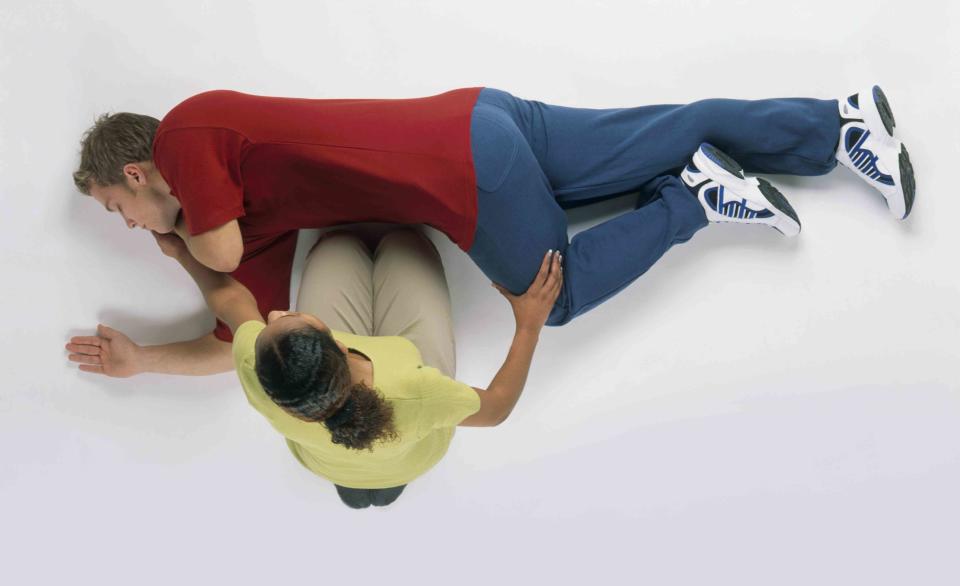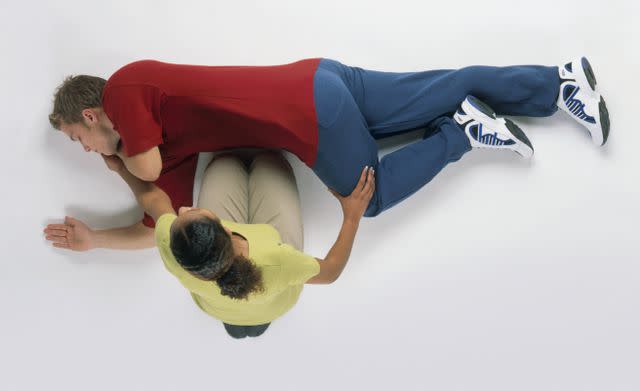What is the Recovery Position?
Does the common first aid practice work?

Medically reviewed by Michael Menna, DO
The recovery position is a body position used in first aid to keep the person still, open their airways, and prevent aspiration, in which a fluid or foreign object (such as food or vomit) enters the lungs or airways by accident, causing the person to choke.
The recovery position should be used when a person has decreased consciousness but is breathing normally and does not need chest compressions or CPR. For example, the recovery position may be used in cases of alcohol poisoning, heat stroke, or when a person is unable to maintain an upright position.
This article outlines when the recovery position should be used, how to properly position the person, and when the recovery position should not be used.

When to Use the Recovery Position
If a person has decreased consciousness but is breathing and has no other life-threatening conditions, they should be placed in the recovery position while waiting for further medical care. Decreased consciousness ranges from sleepiness (somnolence) to unresponsiveness (coma).
First responders will also place a person in the recovery position if there are multiple people with serious injuries at the scene. The recovery position allows the first responder to leave the side of the person with diminished responsiveness, who does not need CPR, to attend to other people who may need CPR or more urgent, life-saving care.
Conditions in which the recovery position are employed include:
Heat stroke
Opioid toxicity (overdose)
Poisoning, including alcohol poisoning
COVID-19 respiratory failure
Post-cardiac arrest, when circulation suddenly returns
Takeaway
If a person is experiencing cardiac arrest or abnormal breathing, or is in need of chest compressions or CPR, they should not be placed in the recovery position. Instead, chest compressions or an automated external defibrillator (AED) should be employed right away.
How to Put Someone in the Recovery Position
First make sure the scene is safe. If it is, the next step is to call 911 and then check to see if the person is conscious or breathing. At this point, you should also look for other serious injuries such as neck injuries.
If the person is breathing but not fully conscious and if no other injuries are present, you can place them in the recovery position while you wait for emergency personnel.
Takeaway
If an unconscious person is not breathing, you must clear the airway before putting them into a recovery position.
To put a person in the recovery position:
Kneel beside them. Make sure they are face up and straighten their arms and legs.
Take the arm closest to you and fold it over their chest.
Take the arm farthest from you and extend it away from the body.
Bend the leg closest to you at the knee.
Support the person's head and neck with one hand. Hold the bent knee, and roll the person away from you.
Tilt the person's head back to keep the airway clear and open.
Who Should Not Be Put in the Recovery Position
The recovery position is widely used in first aid situations, but there are some situations when it is not appropriate. In some cases, moving a person on their side or moving them at all could make their injury worse.
Do not use the recovery position if the person has a head, neck, or spinal cord injury. Additionally the recovery position should not be used when:
The person is experiencing cardiac arrest
The person needs chest compressions or CPR
The person is breathing abnormally (gasping or agonal breathing)
The person is not breathing at all
In these cases, the recovery position may do more harm than good. Rather, cardiopulmonary resuscitation (chest compressions), or the application of an automated external defibrillator (AED) are immediately indicated.
Takeaway
The recovery position is not indicated for children under age 1. Instead, place the baby face down across your forearm. Make sure to support the baby's head with your hand.
What the Recovery Position Is Supposed to Do
The goal of using the recovery position is to allow anything that is regurgitated to drain out of the mouth. The top of the esophagus (food pipe) is right next to the top of the trachea (windpipe). If matter comes up from the esophagus, it could easily find its way into the lungs. This could effectively drown the person or cause what is known as aspiration pneumonia, which is an infection of the lungs caused by foreign material.
Takeaway
Historically, the left-side recovery position was preferred. Recent research, however, suggests that in most cases, it probably doesn't matter which side you put the person on.
Does It Work?
Unfortunately, there isn't much evidence that the recovery position works or doesn't work. This is because research so far has been limited.
What the Science Says
A 2016 study looked at the relationship between the recovery position and hospital admission in 553 children between the ages of 0 and 18 diagnosed with loss of consciousness. The study found that the children who were placed in the recovery position by caregivers were less likely to be admitted to the hospital.
Another study found that placing the person experiencing cardiac arrest in the recovery position could prevent bystanders from noticing if they stop breathing. This could lead to a delay in the administration of CPR.
Research has also found that people with a form of heart disease called congestive heart failure (CHF) do not tolerate the left-side recovery position well.
Despite the limited evidence, the European Resuscitation Council still recommends placing unconscious persons in the recovery position, though it also notes that life signs should be continuously monitored.
How to Help Someone
The recovery position is useful in certain situations, sometimes with adjustments based on the circumstance.
Overdose
There’s more to an overdose than the risk of vomit aspiration. A person who swallowed too many pills may still have undigested capsules in their stomach. Research suggests that the left-side recovery position may help decrease the absorption of certain drugs. This means someone who has overdosed may benefit from being placed in the left-side recovery position until help arrives.
Seizure
Wait until the seizure is over before placing the person in the recovery position. Call 911 if the person injured themselves during the seizure or if they are having trouble breathing afterward.
Also call 911 if this is the first time the person has had a seizure or if the seizure lasts longer than is normal for them. Seizures that last longer than five minutes or multiple seizures that happen in rapid succession are also reasons to seek emergency care.
After CPR
After someone gets CPR and is breathing, your main goals are to make sure the person is still breathing and that nothing is left in the airway if they vomit. That may mean putting them in the recovery position or on their stomach. Make sure to monitor breathing and that you are able to access the airway if you need to clear out objects or vomit.
Summary
The recovery position has been the standard position for unconscious people for many years. There isn't much evidence that it works or doesn't work. A few studies have found benefits, but others have found that the recovery position may delay the administration of CPR or harm people with congestive heart failure.
How you position a person depends on the situation. The recovery position may help keep a person from absorbing a substance they've overdosed on. It can also be helpful for someone who has just had a seizure. Most importantly, an unconscious person needs emergency care, so make sure you call 911 prior to putting them in the recovery position.

